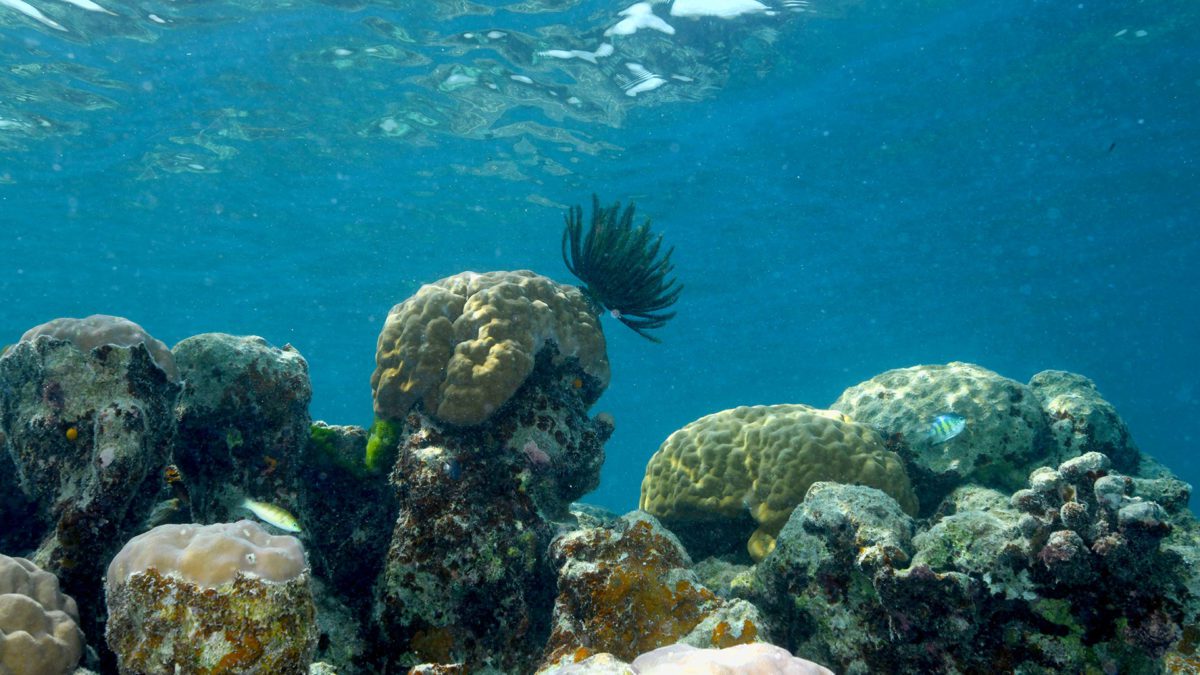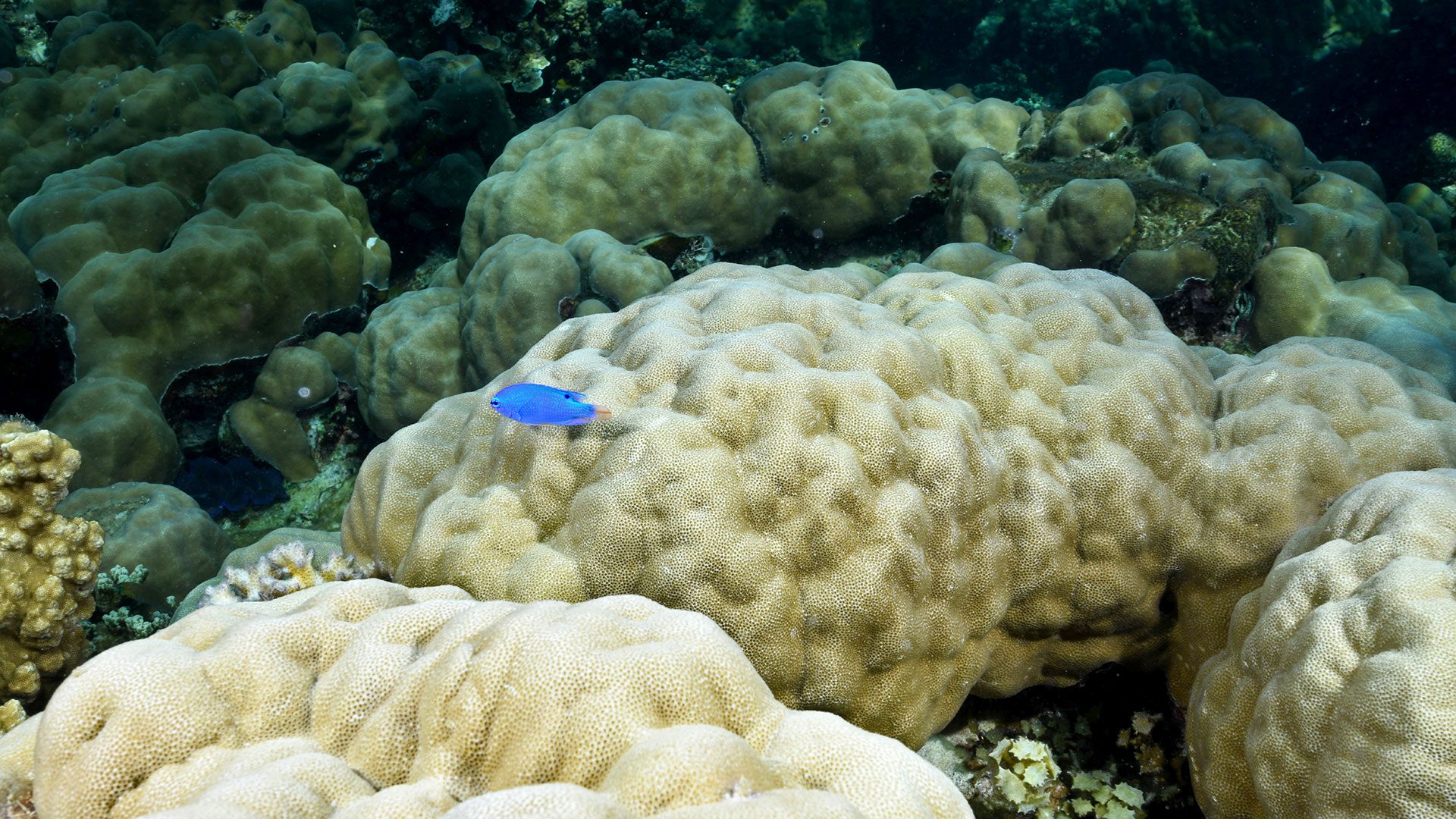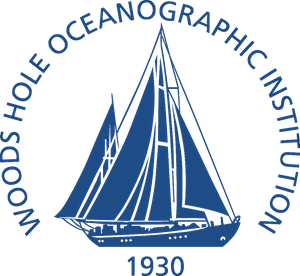From The Woods Hole Oceanographic Institution
12.21.22
Authors:
Hanny E. Rivera1,2,3*
Anne L. Cohen2*
Janelle R. Thompson3,4,5
Iliana B. Baums6
Michael Fox2,7
Kirstin Meyer-Kaiser2
*Corresponding Author
Affiliations:
1 MIT-WHOI Joint Program in Oceanography/Applied Ocean Science & Engineering, Cambridge and Woods Hole, MA.
2 Woods Hole Oceanographic Institution, Woods Hole, MA.
3 Massachusetts Institute of Technology, Cambridge, MA.
4 Asian School of the Environment, Nanyang Technological University, Singapore
5 Singapore Centre for Environmental Life Sciences Engineering (SCELSE), Singapore
6 Pennsylvania State University, State College, PA.
7 Red Sea Research Center, King Abdullah University of Science and Technology (KAUST), Thuwal, Saudi Arabia
Finding could help reef managers to develop new defenses against ocean warming.

Porites cf. lobata is a key reef-building coral that provides habitats for numerous species, including feather stars (comatulid crinoids) and fish. (Photo by Kharis Schrage, ©Woods Hole Oceanographic Institution)
Ocean warming is driving an increase in the frequency and severity of marine heatwaves, causing untold damage to coral reefs. Tropical corals, which live in symbiosis with tiny single celled algae, are sensitive to high temperatures, and exhibit a stress response called bleaching when the ocean gets too hot. In the last 4 decades, marine heatwaves have caused widespread bleaching, and killed millions of corals. Because of this, a global search is underway for reefs that can withstand the heat stress, survive future warming, and act as sources of heat-tolerant coral larvae to replenish affected areas both naturally and through restoration.
Now, scientists studying reefs in Palau, an archipelago in the western tropical Pacific, have identified genetic subgroups of a common coral species that exhibit remarkable tolerance to the extreme heat associated with marine heatwaves. Further, the scientists found evidence that larvae from these corals are traveling from their birthing grounds deep in Palau’s lagoons, to the outer reef, where they survive and grow, and maintain their heat tolerance.
Understanding both the underlying mechanisms that facilitate heat tolerance of these corals, as well as the dispersal capabilities of their larvae will go a long way toward enhancing coral reef conservation and restoration efforts in the 21st century ocean, according to scientists at the Woods Hole Oceanographic Institution who led the research.
In Palau’s main lagoon, a network of very ancient, fossilized reefs has been uplifted to form a series of mountains known as the Rock Islands. These formations slow water flow in and around them, creating localized environments in which the water temperatures are consistently higher than other areas of Palau’s reefs.
Scientists sampled the keystone coral species Porites lobata (lobe coral) across Palau, including the Rock Islands. They took skeletal biopsies and examined the cores for stress bands, which are telltale signs of bleaching, a stress response corals have to high temperatures. They found corals from the Rock Islands bleached less during the intense 1998 heatwave than corals from other areas of the reef, indicating enhanced thermal tolerance.
Scientists then investigated the genetics of the corals and discovered four distinct lineages within the same species. Within the warmer Rock Islands, certain lineages, designated as “LB” and “RD” lineages, were much more common. The scientists were able to match the genetics of each coral with its own bleaching history and found that fewer individuals from the “LB” and “RD” lineages bleached during 1998, indicating enhanced thermal tolerance.

Porites cf. lobata is a key reef-building coral in the tropical Indo-Pacific, providing habitats for many species. (Photo by Kharis Schrage, © Woods Hole Oceanographic Institution)
Remarkably, the scientists found the LB lineage was not restricted to the Rock Islands. They found some LB colonies also living on the cooler outer reefs. An examination of the bleaching histories of these colonies again revealed fewer stress bands, indicating that they maintained the thermal tolerance characteristic of their relatives in the Rock Islands.
“This suggests that the Rock Islands provide naturally tolerant larvae to neighboring areas,” the scientists write in their paper published in Communications Biology [below]. “Finding and protecting such sources of thermally-tolerant corals is key to reef survival under 21st century climate change,” the authors wrote.
“As oceans worldwide continue to warm, corals derived from extreme habitats will be at a competitive advantage and may enable the survival of otherwise vulnerable reefs,” the authors continue. “Identifying and safeguarding natural breeding grounds of environmentally tolerant corals that can thrive under future climate conditions will be fundamental to the persistence of coral reef ecosystems worldwide in the coming decades.”
“We found that some of Palau’s reefs with the highest temperatures have corals that are more tolerant than one would expect,” said the paper’s lead author Hanny Rivera, a graduate of the MIT-WHOI Joint Program. Rivera, who conducted this work as part of her Ph.D. and postdoctoral research, is currently an associate director of business development at Ginko Bioworks. “In addition, they are genetically distinct from the same corals found in other parts of Palau, which suggests that there has been natural selection for hardier corals in these regions.”.
Paper co-author Michael Fox added that the study is particularly exciting because it combines coral genetics with historical records of bleaching preserved in their skeletons to shed light on how corals from extreme habitats with high temperature tolerance can be dispersed across a reefscape. “This integrated perspective is essential for improving projections of coral communities in a warming ocean,” said Fox, who was a postdoctoral scholar at WHOI during the research for this paper. He currently is an assistant research professor in the Red Sea Research Center at King Abdullah University of Science and Technology in Thuwal, Saudi Arabia.
The Palau research is directly related to the Super Reefs initiative WHOI launched with The Nature Conservancy and Stanford University to locate coral communities that can withstand marine heat waves, and work with local communities and governments to protect them.
“This work is the scientific basis for the Super Reefs initiative,” said paper co-author Anne Cohen, a scientist at WHOI and Rivera’s advisor on the study. “The Palau research demonstrates that Super Reefs exist and also provides actionable science knowledge that can be used to support their protection.”
Cohen noted that there are other coral reefs, not just in Palau, where coral communities have not bleached as severely as scientists predicted based on the levels of thermal stress. “When we find the coral communities that are heat-tolerant or bleaching-resistant, and we protect them from other stresses that can kill them—like dynamiting, overfishing, or coastal development— they will produce millions of larvae that will travel on the currents, outside of their places of origin as we see on Palau, and they will repopulate reefs that have been devastated by heatwaves,” she said. “Nature is amazing. Our job with the Super Reefs initiative is to protect these thermally resilient reefs and let nature do the rest.”
Rivera added she is in awe of the immense appreciation, respect, and stewardship that the Palauan people have for their environment.
“They have been one of the pioneering countries in promoting marine conservation and ecological protection. It is wonderful to know that these special reefs are in such good hands,” Rivera said. “It is my greatest hope that our research will further support the Palauan people in their efforts to maintain a healthy marine ecosystem.”
Funding for this research was provided by the National Science Foundation, The Seija Family, The Arthur Vining Davis Foundation, the Atlantic Charter Donor Advised Fund, The Dalio Foundation, Inc., the MIT Sea Grant Office, the Woods Hole Oceanographic Institution Coastal Ocean Institute Grant and Ocean Venture Fund, the National Defense Science and Engineering Graduate Fellowship Program, the Martin Family Fellowship for Sustainability the American Association of University Women Dissertation Fellowship, and an Angell Family Foundation Grant.
Science paper:
Communications Biology
See the science paper for instructive material with images.
See the full article here .
Comments are invited and will be appreciated, especially if the reader finds any errors which I can correct. Use “Reply”.
five-ways-keep-your-child-safe-school-shootings
Please help promote STEM in your local schools.

Mission Statement
The Woods Hole Oceanographic Institution is dedicated to advancing knowledge of the ocean and its connection with the Earth system through a sustained commitment to excellence in science, engineering, and education, and to the application of this knowledge to problems facing society.
Vision & Mission
The ocean is a defining feature of our planet and crucial to life on Earth, yet it remains one of the planet’s last unexplored frontiers. For this reason, WHOI scientists and engineers are committed to understanding all facets of the ocean as well as its complex connections with Earth’s atmosphere, land, ice, seafloor, and life—including humanity. This is essential not only to advance knowledge about our planet, but also to ensure society’s long-term welfare and to help guide human stewardship of the environment. WHOI researchers are also dedicated to training future generations of ocean science leaders, to providing unbiased information that informs public policy and decision-making, and to expanding public awareness about the importance of the global ocean and its resources.
The Institution is organized into six departments, the Cooperative Institute for Climate and Ocean Research, and a marine policy center. Its shore-based facilities are located in the village of Woods Hole, Massachusetts and a mile and a half away on the Quissett Campus. The bulk of the Institution’s funding comes from grants and contracts from the National Science Foundation and other government agencies, augmented by foundations and private donations.
WHOI scientists, engineers, and students collaborate to develop theories, test ideas, build seagoing instruments, and collect data in diverse marine environments. Ships operated by WHOI carry research scientists throughout the world’s oceans. The WHOI fleet includes two large research vessels (R/V Atlantis and R/V Neil Armstrong); the coastal craft Tioga; small research craft such as the dive-operation work boat Echo; the deep-diving human-occupied submersible Alvin; the tethered, remotely operated vehicle Jason/Medea; and autonomous underwater vehicles such as the REMUS and SeaBED.
WHOI offers graduate and post-doctoral studies in marine science. There are several fellowship and training programs, and graduate degrees are awarded through a joint program with the Massachusetts Institute of Technology. WHOI is accredited by the New England Association of Schools and Colleges . WHOI also offers public outreach programs and informal education through its Exhibit Center and summer tours. The Institution has a volunteer program and a membership program, WHOI Associate.
On October 1, 2020, Peter B. de Menocal became the institution’s eleventh president and director.
History
In 1927, a National Academy of Sciences committee concluded that it was time to “consider the share of the United States of America in a worldwide program of oceanographic research.” The committee’s recommendation for establishing a permanent independent research laboratory on the East Coast to “prosecute oceanography in all its branches” led to the founding in 1930 of the Woods Hole Oceanographic Institution.
A $2.5 million grant from the Rockefeller Foundation supported the summer work of a dozen scientists, construction of a laboratory building and commissioning of a research vessel, the 142-foot (43 m) ketch R/V Atlantis, whose profile still forms the Institution’s logo.
WHOI grew substantially to support significant defense-related research during World War II, and later began a steady growth in staff, research fleet, and scientific stature. From 1950 to 1956, the director was Dr. Edward “Iceberg” Smith, an Arctic explorer, oceanographer and retired Coast Guard rear admiral.
In 1977 the institution appointed the influential oceanographer John Steele as director, and he served until his retirement in 1989.
On 1 September 1985, a joint French-American expedition led by Jean-Louis Michel of IFREMER and Robert Ballard of the Woods Hole Oceanographic Institution identified the location of the wreck of the RMS Titanic which sank off the coast of Newfoundland 15 April 1912.
On 3 April 2011, within a week of resuming of the search operation for Air France Flight 447, a team led by WHOI, operating full ocean depth autonomous underwater vehicles (AUVs) owned by the Waitt Institute discovered, by means of sidescan sonar, a large portion of debris field from flight AF447.
In March 2017 the institution effected an open-access policy to make its research publicly accessible online.
The Institution has maintained a long and controversial business collaboration with the treasure hunter company Odyssey Marine. Likewise, WHOI has participated in the location of the San José galleon in Colombia for the commercial exploitation of the shipwreck by the Government of President Santos and a private company.
In 2019, iDefense reported that China’s hackers had launched cyberattacks on dozens of academic institutions in an attempt to gain information on technology being developed for the United States Navy. Some of the targets included the Woods Hole Oceanographic Institution. The attacks have been underway since at least April 2017.

